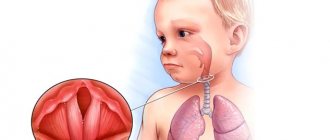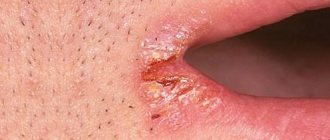What is stomatitis?
Stomatitis, which means “mouth” in ancient Greek, is the most common name for a group of diseases of the oral mucosa. The disease should not be confused with glossitis (damage to the tongue), cheilitis (damage to the lips) and palatinitis (damage to the palate). Stomatitis is not contagious, but almost every person has directly or indirectly encountered one or another type of the disease. Once you have been ill, the chance of recurrence of the disease is very high.
Correctly diagnosing stomatitis is difficult. The doctor often assesses the situation only visually - in medicine there are no special tests for this disease. The difficulty of diagnosing stomatitis also lies in the fact that it can be a symptom of more serious diseases.
Literature:
- Fungal, viral and traumatic stomatitis in a therapeutic dentistry clinic. Tutorial. Edited by Dr.Med.Sc. K.G. Karakova - Stavropol. Publishing and information, 2013. – 100 p.
- Pankrusheva T.A., Maravina I.N., Chekmareva M.S. Research on the development of the composition and technology of tablets for the treatment of stomatitis // Scientific result. Medicine and pharmacy. – T.4, No. 1, 2022, pp. 78-88.
- Tilis S.Yu. Stomatitis. Nurse, 2010, No. 2.
- Glukhmanyuk D.S., Malinovsky V.A. Aphthous stomatitis. Proceedings of the scientific and practical conference “Modern problems of pharmacology, cosmetology and aromology.” International Humanitarian University, Odessa Medical Institute, 2015. (Current problems of pharmacology, cosmetology and aromology: Materials of the scientific and practical conference dedicated to the 160th birthday of a prominent Ukrainian pathologist, endocrinologist, immunologist , microbiologist, professor Volodymyr Valerianovich Pidvysotsky and Pharmacist Day. m. Odessa, June 15, 2022 – Odessa: International Humanitarian University, 2015. – 48 p.)
- Volkova, M.N. Diseases of the oral mucosa: educational and methodological manual / M.N. Volkova, Yu.P. Chernyavsky, N.A. Sakharuk, Yu.R. Elenskaya. – Vitebsk: VSMU, 2016. – 236 p.
- Therapeutic dentistry: textbook: in 3 hours / ed. G.M. Barera. - M. : GEOTAR-Media, 2005. - Part 3. - 288 p.
- Galizina O.A. Main aspects of the occurrence, clinical manifestations, treatment and prevention of chronic recurrent aphthous stomatitis. Russian Dental Journal, 2014, No. 6, pp. 39-43.
- Instructions for the medical use of the drug Metrogyl Denta® Dental gel // Registration number P N015982/01 // State Register of the Russian Federation. – URL: https://grls.rosminzdrav.ru/Grls_View_v2.aspx?routingGuid=9bc9a05c-d28b-…
- Dental gel for gums Metrogyl Denta® in the treatment of periodontal diseases and oral mucosa. Practical medicine, No. 1(33), March, 2009, pp. 105-106.
- Strakhova S.Yu., Drobotko L.N. Chronic recurrent aphthous stomatitis (lecture). RMZh, No. 29 from December 27, 2006, p. 2096
Causes of stomatitis
The mechanism of stomatitis, unfortunately, has not yet been fully identified, so there are many causes of the disease:
- microorganisms that cause infection, acting directly on the oral mucosa;
- diseases of the gastrointestinal tract;
- diseases of the cardiovascular system;
- general weakening of the immune system;
- avitaminosis;
- metabolic disorders;
- nervous disorders;
- malignant tumors;
- hormonal fluctuations;
- various injuries in the form of abrasions of the oral mucosa;
- anemia;
- heredity.
Among the causes of stomatitis there are also local factors. Elementary lack of oral hygiene, caries, dysbacteriosis, poorly made or poorly installed dentures, the consequences of using medications, nicotine and alcohol consumption, as well as allergic reactions to products. Of particular note is the use of toothpastes containing sodium lauryl sulfate. Various studies have proven that they provoke the occurrence of stomatitis and its exacerbation.
Why is stomatitis in the mouth dangerous? Methods of transmission of the disease
There are many types of stomatitis, but not all of them are contagious. The most common methods of infection:
- airborne and contact (through kissing, sharing dishes, sneezing, etc.) - characteristic of bacterial and viral stomatitis;
- Candidiasis is also transmitted through hygiene items, household items, and toys;
- types of diseases such as chronic, aphthous, chemical, allergic, etc. develop independently (under the influence of unfavorable factors).
Children most often become infected through toys, fruits, dirty hands, dishes, that is, through contact. Babies put everything in their mouth and can get candidiasis after playing with a dirty toy or from an untreated pacifier.
What negative consequences can stomatitis lead to?
- inflammation and bleeding of gums;
- tooth mobility and tooth loss;
- secondary infection;
- tonsillitis;
- with long-term treatment, voice changes (hoarseness, hoarseness) and the development of chronic laryngitis are possible.
But in most cases, stomatitis does not pose a health hazard under one condition - if a visit to the doctor is not postponed, effective treatment is prescribed in a timely manner and the patient follows the recommendations of doctors for treatment and oral hygiene.
Symptoms of stomatitis
Light redness of the oral mucosa is the first symptom of stomatitis. Over time, they swell and a burning sensation appears. If treatment is not started at this stage, the redness is replaced by small oval or round ulcers, grayish or white, with a red halo and a film on top. Moreover, the tissue around them looks absolutely healthy. Mouth ulcers are very painful and make eating difficult. They appear on the inner surface of the cheeks and lips, under the tongue. In most cases, mild stomatitis manifests itself as one ulcer.
The appearance of several ulcers of larger size and depth, which sometimes merge into one, are signs of more severe forms of stomatitis. The appearance of ulcers is accompanied by fever, inflammation of the lymph nodes, general deterioration of health, headache, loss of appetite and constipation. Acute stomatitis is accompanied by severe pain in the mouth, which interferes with eating and speaking. In addition, there may be excessive salivation, a coating on the tongue, a bright red mouth, irritability, and vomiting after eating.
Features of the manifestation of stomatitis in the mouth during pregnancy
The main causes of stomatitis in pregnant women are hormonal changes and decreased immunity, and these are ideal conditions for any inflammatory processes.
Stomatitis during pregnancy manifests itself in the form of redness on the tongue, palate, buccal mucous membranes and gums. In the area of inflammation, ulcers and erosions appear in the form of white spots with a red outline. If stomatitis occurs in an expectant mother, treatment should be carried out immediately, since each ulcer is a source of infection that can cause intoxication of the body, lead to serious problems in bearing the fetus and complications during childbirth.
Types of stomatitis
There are many types of oral stomatitis.
Catarrhal stomatitis
The most common type of stomatitis. With this unpleasant disease, the oral mucosa becomes swollen, painful, hyperemic, and may be covered with a white or yellow coating. There is an increased secretion of saliva. All this may be accompanied by bleeding gums and bad breath. The causes are local factors: poor hygiene, caries, tartar, oral candidiasis. Catarrhal stomatitis also occurs as a result of diseases of the gastrointestinal tract and worms.
Ulcerative stomatitis
A more severe disease than catarrhal disease. It can develop independently or be an advanced form of catarrhal stomatitis. Most often it develops in people suffering from gastric ulcers or chronic enteritis, diseases of the cardiovascular system and blood, infections and poisoning. With ulcerative stomatitis, the entire thickness of the mucous membrane is affected, there is an increase in temperature to 37.5 0C, weakness, headache, enlargement and tenderness of the lymph nodes. Eating is accompanied by severe pain.
Aphthous stomatitis
Causes of the disease: gastrointestinal tract, allergic reactions, viral infections, rheumatism, and heredity. Aphthous stomatitis has symptoms:
- the appearance on the oral mucosa of single or multiple aphthae - small ulcers (3 - 5 millimeters) of gray-white color with a narrow red rim;
- bad feeling;
- increased temperature and pain of ulcerative lesions.
The disease can have an acute form or occur chronically with periods of exacerbation and remission, the so-called chronic recurrent aphthous stomatitis.
Candidal stomatitis
It is a fungal disease that most often appears in young children (stomatitis in children) and the elderly. This type of stomatitis is caused by a fungus (usually the Candida genus) and develops mainly when the body’s immune forces decrease, as a result of long-term treatment with strong antibacterial drugs, as well as against the background of another chronic disease. Candidal stomatitis has the following symptoms:
- burning sensation in the mouth and larynx,
- white coating on the tongue and mouth,
- hyperemia and bleeding of the mucous membrane,
- bad taste in the mouth or loss of taste.
This type of stomatitis is considered contagious and can be transmitted both through household and sexual contact.
Herpetic or herpes stomatitis
Occurs in both adults and children. It is caused by the herpes simplex virus and can be acute or chronic. Symptoms of herpetic stomatitis:
- in mild cases, small blisters appear, resembling aphthae;
- the severe form is characterized by multiple rashes on the mucous membrane;
- swelling and inflammation of the lining of the oral cavity;
- increased salivation;
- general malaise;
- toxicosis;
- elevated temperature;
- enlarged lymph nodes;
- burning sensation and pain when eating.
The peculiarity of herpetic stomatitis is that the herpes virus remains in the body forever.
Allergic stomatitis also occurs; read more about the disease in the article.
Allergic stomatitis
It is an allergic disease that can occur in both adults and children. Its etiology is different: if in childhood the allergen is most often food products introduced into the child’s diet for the first time, then in adult patients the triggering mechanism for the pathological reaction may be weakening of the immune system due to the use of certain medications, rejection of dentures or advanced inflammatory processes in the oral cavity.
The characteristic signs of allergic stomatitis are:
- itching in the mouth, increasing after eating;
- severe swelling of the oral mucosa;
- secretion of a large amount of thick saliva;
- hyperthermia;
- unbearable pain;
- bad breath.
For the treatment of allergic stomatitis, in addition to visiting a dentist, consultation with an immunologist and an infectious disease specialist is recommended.
Questions and answers
— Which doctor treats stomatitis in adults?
— The dentist deals with the treatment and prevention of stomatitis. He is also competent to diagnose the type of pathology and select an adequate therapeutic regimen. Since stomatitis in adults often acts as a symptom, consultation with another specialist is possible: a gastroenterologist, an infectious disease specialist, an endocrinologist, an allergist.
— How long does stomatitis last?
— Depending on the type and severity of stomatitis, the inflammatory process should subside within 7-10 days, and two weeks after the onset of the disease, complete recovery occurs. If alarming symptoms do not go away within the specified period, you need to contact your dentist again to find out the reasons or adjust treatment measures.
— What medicine helps with stomatitis?
— Unfortunately, a universal remedy for stomatitis is still unknown to science. Stomatitis is a group of pathologies, the causes of origin and manifestations are diverse. The development of pathology is influenced by factors such as the decline of the body’s immune forces, concomitant systemic diseases, and stress. The decision to prescribe a particular drug is made individually, depending on the clinical picture and characteristics of the body. When two different people have the same diagnosis, therapeutic measures differ.
How to treat stomatitis?
Any treatment for stomatitis begins with a professional hygienic cleaning procedure, during which tartar and soft plaque are removed. Almost any dental clinic in Moscow provides a similar service. Teeth affected by caries are treated. The mucous membrane is treated with antiseptic rinses. During the day, rinse the mouth with a warm solution of chamomile or calendula decoction. With timely treatment, catarrhal stomatitis disappears in 5–10 days. For ulcerative or aphthous stomatitis, local treatment is combined with general treatment. In addition to professional oral hygiene, antiseptic procedures are carried out in the clinic where stomatitis is treated.
If the presence of herpetic stomatitis is suspected, additional antiviral therapy is carried out. In case of oral candidiasis, treatment is prescribed with antifungal drugs. If the cause of stomatitis is some other disease, for example, the stomach or intestines, then it is necessary to begin to treat the root cause. During the treatment process, you should definitely follow a diet limiting spicy, hot, cold, sour and rough foods. A side effect of taking medications can be a green coating on the tongue.
Ulcerative (necrotizing) gingivitis
This is nothing more than an advanced form of catarrhal stomatitis in adults, in which most of the oral mucosa is affected by ulcerative and erosive foci, redness, swelling and bleeding of the gums, a slight increase in temperature to 37.5°, pain in the gums. In more severe cases (in the absence of timely effective treatment), stomatitis on the cheek can develop into extensive ulcers (up to 6 cm in diameter), deep tissue necrosis (mucous and even muscle), temperature rise to critical values, transition to the chronic stage, loss teeth.
How many days it takes to treat ulcerative stomatitis depends on the severity of the disease and individual factors. With the use of modern methods and remedies against the disease, you can quickly get rid of the disease (in 5-10 days).
Possible complications
If stomatitis in the mouth is left untreated, it will certainly lead to negative consequences, from gum inflammation to tooth loss. That is why it is extremely important when treating stomatitis to strictly adhere to the recommendations given by your dentist. The list of major potential complications includes the following diseases.
- Chronic stomatitis.
Statistically, this is the most common complication. An untreated inflammatory process becomes chronic and recurrent, which means that an infectious focus will always be present in the body. - Appearance of scars.
A symptom such as bleeding gums can be a manifestation of many diseases, but with stomatitis, due to constant non-healing cracks in the oral cavity, scar tissue forms, which in the future may not allow the patient to open his mouth wide. - Laryngitis.
If the infection spreads up the respiratory tract, the patient's voice becomes hoarse and a cough appears. - Vision problems.
With advanced herpetic stomatitis, the target of damage becomes not only the gums, but also the mucous membranes of other organs. Most often, these are the eyes and genitals. - Loss of teeth.
The most dangerous complication of stomatitis. The main threat is the fact that the destructive process can last for many years and may not be noticeable to the patient at first. First, periodontal disease will develop - serious damage to periodontal tissue. And only then, as a consequence, the teeth will gradually become looser until they fall out.
Babies are more susceptible to the disease.
Firstly, because they love to taste everything. As a result, any thing can be in a child’s mouth (toys, someone else’s pacifier, an apple uneaten by another child), covered with a million unfriendly bacteria that can cause inflammation.
Secondly, even the slightest cold can affect the condition of the mucous membrane. Dry mouth leads to a decrease in the protective function of the mucous membrane.
Thirdly, during the period when the baby is teething, he can injure his cheek or lips on the inside during sleep. Inflammation forms at the site of injury, and then stomatitis develops.
Doctors recommend that parents regularly examine the child’s mouth, especially in the area behind the lower lip, where foci of inflammation are almost always localized during stomatitis. Childhood stomatitis is very painful, and early detection of the disease will help get rid of it in a matter of days.
How to cure stomatitis in a child? Under no circumstances use tips from the Internet and do not try to treat your baby with folk remedies yourself. If you suspect that your child has stomatitis, contact a pediatric dentist at Amel Dental Clinic for a consultation. He will conduct an examination, draw up a treatment plan and give professional recommendations.
Stomatitis and treatment at home
Treatment of stomatitis at home primarily involves the use of various herbal decoctions and infusions with antiseptic, anti-inflammatory and immunostimulating effects. For example, even doctors recommend rinsing with calendula - it has a strong antimicrobial and anti-inflammatory effect and promotes healing. Chamomile is an excellent antiseptic - it is one of the most popular remedies that is widely used in folk and official medicine.
Stomatitis is treated using folk remedies not only for rinsing, but also for oral administration. For example, rosehip decoction is a real storehouse of vitamins and other substances necessary for the human body. It improves immunity, prevents the development of inflammatory processes, and also helps destroy harmful bacteria. Despite the miraculous power of herbs, it should be remembered that candida and herpetic stomatitis will not be eliminated by such folk treatment, since fungi and viruses are not affected by antiseptic, anti-inflammatory and immune-modifying agents.
Prevention of stomatitis
The basis for the prevention of stomatitis is compliance with the rules of oral hygiene. Brushing your teeth twice a day with an ultrasonic brush and visiting a hygienist every six months are mandatory. It is important to monitor the general condition of your teeth. Wearing braces or dentures will require special attention, as they can injure the oral mucosa.
To prevent stomatitis, it is very important to be careful about your diet. Using special tests, it is recommended to identify and exclude foods that cause allergies from the diet. You should not eat foods that have a traumatic or irritating effect on the oral mucosa: crispy, salty, hot and spicy foods. Tomato and orange juices and alcohol are not recommended. The diet must be sufficiently balanced, since a lack of vitamins and microelements can cause an attack of the disease. Remember that stomatitis is always recurrent, that is, it occurs periodically during periods of general weakening of the body.
If you have had stomatitis at least once in your life, there will always be a risk of it occurring again. Therefore, prevention comes to the fore. Avoid bad habits, stick to a diet, try not to be nervous and, of course, maintain oral hygiene!
Prosthetic stomatitis in an adult
From the name it is clear that this stomatitis is associated with dentures. It can be allergic and bacterial.
- Allergic stomatitis is the body’s reaction to the components of the prosthesis, namely the monomer of acrylic plastic. As a rule, this type of allergy appears due to the fault of the dental technician, when the proportions are not observed when mixing the plastic for the base of the prosthesis. If there is more monomer than needed, then it remains free in the finished prosthesis and then is released out, irritating the mucous membrane of the prosthetic bed. There are, of course, cases of real allergies, but they are rare.
- Bacterial stomatitis is the result of the action of bacteria adhering to the prosthesis on the mucous membrane. Together with humans, bacteria consume food and throw out toxic waste products. All these substances remain under the denture, and if the patient does not clean the denture or cleans it rarely or poorly, then he has every chance of “earning” such bacterial stomatitis.
Symptoms
Both variants of prosthetic stomatitis manifest themselves in the form of redness, swelling, and soreness of the mucous membrane clearly along the border of the edge of the prosthetic bed and do not affect the remaining mucous membranes.
Treatment
Treatment of prosthetic stomatitis depends on its form:
- If allergic stomatitis, then it is necessary to replace the denture (insist that the technician follow the instructions when mixing the plastic) or make a denture from a different material (for partial removable dentures there are now many options for base plastics).
- In the case of bacterial stomatitis, cleaning and polishing of the prosthesis is necessary (preferably in a laboratory), since by scraping off plaque at home, you can scratch the prosthesis, thereby creating additional places for microbes to conveniently settle.











